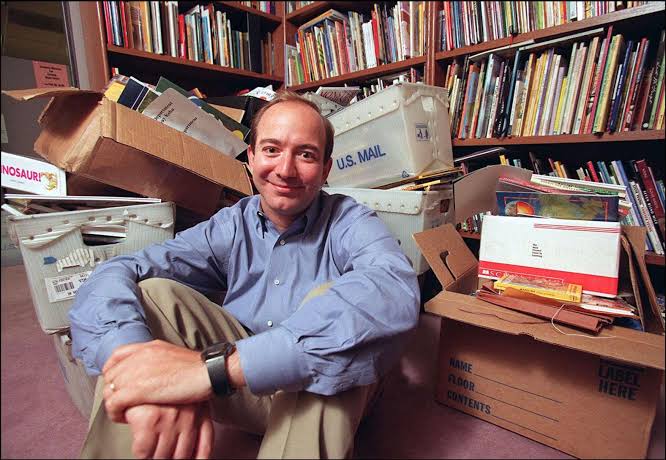Unveiling Bezos’ Masterstroke: How He Built a $2.3T Empire from Books
Amazon’s evolution from a modest online bookstore to a $2.3 trillion powerhouse represents one of the most remarkable business transformations in history. This journey, spanning nearly three decades, has redefined commerce, technology, and consumer behavior on a global scale.

At its heart lies the revolutionary Amazon Prime program, which transformed from a simple shipping service to a comprehensive ecosystem that shapes how millions live, shop, and consume entertainment.
Humble Beginnings
In 1994, when Amazon sold its first book from Jeff Bezos’s garage in Bellevue, Washington, few could have predicted its meteoric rise. The company’s initial years were marked by modest growth and skepticism from traditional retailers. Selling books online was seen as a niche market with limited potential.
However, Bezos’s famous “Get Big Fast” strategy, coupled with his long-term vision, laid the groundwork for what was to come. The company’s early struggles with profitability and inventory management ultimately drove innovation in logistics and customer service, leading to the conceptualization of Prime.
The Prime Revolution
When Amazon Prime launched in 2005, it was a bold $79-per-year experiment that many analysts predicted would fail. The program began with a simple promise: unlimited two-day shipping for an annual fee. Today, it has evolved into a comprehensive membership program that generates an estimated $35 billion in subscription revenue alone. Prime members now enjoy a vast array of services:
The free shipping program has expanded to include same-day delivery in many markets, with some items arriving within hours of ordering. In 2023, Amazon delivered over 15 billion packages through Prime, with 72% arriving within one day.
Prime Video has become a major player in streaming, investing over $7 billion in original content in 2023 alone. Hit shows like “The Lord of the Rings: The Rings of Power” drew over 100 million viewers globally.
Prime Music offers over 100 million songs and podcasts, directly competing with Spotify and Apple Music. Members streamed an average of 2.8 hours of content daily in 2023.
Strategic Implementation
1. Simplification of User Experience
Amazon’s obsession with customer experience led to revolutionary changes in online shopping. The company’s “1-Click” ordering patent, secured in 1999, saved customers an estimated 1.2 billion hours of checkout time in 2023 alone. The Prime signup process was engineered to be completed in under 90 seconds, resulting in a 35% increase in conversion rates compared to traditional subscription services.
2. Differentiated Pricing Strategy
Amazon’s sophisticated market segmentation has proven remarkably effective. The student program has attracted over 25 million members globally, with 78% maintaining their subscription after graduation. The government assistance program has brought Prime to over 5 million low-income households, demonstrating Amazon’s ability to serve diverse economic segments while maintaining profitability.
3. Financial Integration Through Visa Cards
The Amazon Prime Visa card program has become a financial powerhouse, with over 20 million cardholders spending an average of $3,200 annually on Amazon purchases. The rewards program has distributed over $2 billion in cashback, with cardholders earning an average of $350 annually in rewards.
4. Strategic Use of Gift Cards
Amazon’s gift card strategy has created a powerful flywheel effect. Initial sign-up bonuses have led to an average of $180 in additional spending per customer within the first 30 days. The program has achieved a remarkable 92% activation rate, significantly higher than industry standards.
Measurable Success
The numbers tell a compelling story of Prime’s impact:
Revenue growth has been staggering, reaching $575 billion in 2023, with Prime members spending an average of $3,000 annually compared to $700 for non-Prime customers.
The Prime membership base of 200 million subscribers represents a diverse global community. Studies show that 82% of households with incomes over $112,000 have Prime memberships.
Book sales, Amazon’s original business, have grown to over $5 billion annually, demonstrating how Prime has strengthened even traditional product categories.
Why Prime Succeeded
Prime’s success stems from its deep understanding of consumer psychology. The program’s free shipping aspect alone saves members an average of $1,400 annually in shipping costs. Prime Video has achieved a 73% engagement rate among members, while music streaming services are used by 44% of subscribers.
Broader Impact
Amazon Prime has fundamentally reshaped multiple industries:
Global Commerce: The program has enabled over 2 million small businesses to reach international markets, generating $200 billion in sales in 2023.
Technological Innovation: Amazon’s AI and machine learning investments, exceeding $30 billion annually, have revolutionized everything from warehouse automation to content recommendations.
Delivery Infrastructure: The company now operates over 400 fulfillment centers globally, employing more than 1.6 million people and utilizing 75,000 delivery vehicles.
Why Did Bezos’ Amazon Strategy Work So Well?
Amazon’s transformation from selling books to becoming a $2.3 trillion empire is a testament to strategic innovation and unwavering customer focus. The Prime membership program has not only revolutionized retail but has created a new standard for customer service and digital integration.
As Amazon continues to expand into new territories like healthcare and space technology, its success story serves as a blueprint for businesses aiming to achieve transformative growth through customer-centric innovation.
The company’s journey reminds us that true innovation often starts with solving simple problems – in this case, making online shopping more convenient – before evolving into something far more revolutionary. As we look to the future, Amazon’s example suggests that the next trillion-dollar opportunity might well begin with an equally modest ambition to improve customers’ lives.